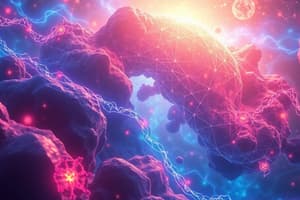Podcast
Questions and Answers
What is the primary role of adenosine triphosphate (ATP) in living cells?
What is the primary role of adenosine triphosphate (ATP) in living cells?
- To facilitate cellular respiration
- To synthesize proteins
- To act as a store of energy rich phosphate bonds (correct)
- To store genetic information
Which form of energy can living cells utilize?
Which form of energy can living cells utilize?
- Chemical energy from carbohydrates
- Energy rich phosphate bonds (correct)
- Thermal energy
- Mechanical energy
Why can living cells not use energy directly from glucose?
Why can living cells not use energy directly from glucose?
- Energy from glucose is too unstable
- Glucose cannot be transported into cells
- They lack enzymes to break down glucose
- They can only use energy in the form of energy rich phosphate bonds (correct)
What type of biochemical bond is primarily involved in ATP’s storage of energy?
What type of biochemical bond is primarily involved in ATP’s storage of energy?
In which cellular process is ATP primarily utilized?
In which cellular process is ATP primarily utilized?
Which of the following activities are primarily involuntary and essential for survival?
Which of the following activities are primarily involuntary and essential for survival?
What role do involuntary activities play in the human body?
What role do involuntary activities play in the human body?
Which of the following is least likely to be classified as an involuntary activity?
Which of the following is least likely to be classified as an involuntary activity?
Involuntary activities are crucial for what aspect of human biology?
Involuntary activities are crucial for what aspect of human biology?
Which of the following statements about involuntary activities is true?
Which of the following statements about involuntary activities is true?
Which factor does physical activity primarily increase?
Which factor does physical activity primarily increase?
Which of the following activities would be considered part of physical activity?
Which of the following activities would be considered part of physical activity?
What types of energy expenditures are included in the definition of physical activity?
What types of energy expenditures are included in the definition of physical activity?
Which of the following is NOT a component of physical activity?
Which of the following is NOT a component of physical activity?
What is a consequence of increased physical activity on the body?
What is a consequence of increased physical activity on the body?
What does specific dynamic action (SDA) primarily increase?
What does specific dynamic action (SDA) primarily increase?
Which of the following statements accurately reflects the nature of SDA?
Which of the following statements accurately reflects the nature of SDA?
How is the effect of SDA best characterized in relation to metabolic processes?
How is the effect of SDA best characterized in relation to metabolic processes?
Which factor is NOT a contributor to the effect of SDA?
Which factor is NOT a contributor to the effect of SDA?
In what context does SDA typically manifest?
In what context does SDA typically manifest?
Which of the following is NOT one of the three forms of physical activities?
Which of the following is NOT one of the three forms of physical activities?
What is the primary location where glycogen is stored in the body?
What is the primary location where glycogen is stored in the body?
Which of the following accurately reflects the amount of glycogen stored in the body?
Which of the following accurately reflects the amount of glycogen stored in the body?
What type of physical activity would most likely be considered moderate work?
What type of physical activity would most likely be considered moderate work?
Which of the following pairs correctly links a type of physical activity with its corresponding energy store?
Which of the following pairs correctly links a type of physical activity with its corresponding energy store?
What is the primary factor that indicates energy balance in the body?
What is the primary factor that indicates energy balance in the body?
Which equation correctly represents the concept of energy balance?
Which equation correctly represents the concept of energy balance?
If an individual is in a state of energy balance, what is the likely outcome regarding their body weight?
If an individual is in a state of energy balance, what is the likely outcome regarding their body weight?
Which of the following best describes the role of food energy in achieving energy balance?
Which of the following best describes the role of food energy in achieving energy balance?
What does a consistent deviation from energy balance suggest about an individual's lifestyle?
What does a consistent deviation from energy balance suggest about an individual's lifestyle?
Flashcards
Involuntary Activities
Involuntary Activities
Activities that happen automatically and are essential for survival, like heartbeat, breathing, and maintaining body temperature.
Heartbeat
Heartbeat
The pumping of blood by the heart, bringing oxygen and nutrients to the body.
Respiration
Respiration
The process of taking in oxygen and releasing carbon dioxide.
Maintaining Body Temperature
Maintaining Body Temperature
Signup and view all the flashcards
Vital Activities
Vital Activities
Signup and view all the flashcards
What is ATP?
What is ATP?
Signup and view all the flashcards
How does ATP store energy?
How does ATP store energy?
Signup and view all the flashcards
Why is ATP important for cells?
Why is ATP important for cells?
Signup and view all the flashcards
What happens when ATP releases energy?
What happens when ATP releases energy?
Signup and view all the flashcards
How is ATP replenished?
How is ATP replenished?
Signup and view all the flashcards
BMR (Basal Metabolic Rate)
BMR (Basal Metabolic Rate)
Signup and view all the flashcards
Physical Activity
Physical Activity
Signup and view all the flashcards
Exercise
Exercise
Signup and view all the flashcards
Energy for Work, Recreation, and Mental Activity
Energy for Work, Recreation, and Mental Activity
Signup and view all the flashcards
Physical Activity and BMR
Physical Activity and BMR
Signup and view all the flashcards
Specific Dynamic Action (SDA)
Specific Dynamic Action (SDA)
Signup and view all the flashcards
Why does SDA occur?
Why does SDA occur?
Signup and view all the flashcards
Which macronutrient has the highest SDA?
Which macronutrient has the highest SDA?
Signup and view all the flashcards
Does SDA apply to all foods?
Does SDA apply to all foods?
Signup and view all the flashcards
How long does SDA last?
How long does SDA last?
Signup and view all the flashcards
Sedentary/Light Work
Sedentary/Light Work
Signup and view all the flashcards
Moderate Work
Moderate Work
Signup and view all the flashcards
Heavy Work
Heavy Work
Signup and view all the flashcards
Glycogen
Glycogen
Signup and view all the flashcards
Body's Energy Stores
Body's Energy Stores
Signup and view all the flashcards
What is energy balance?
What is energy balance?
Signup and view all the flashcards
How is energy balance achieved?
How is energy balance achieved?
Signup and view all the flashcards
Why is energy balance important?
Why is energy balance important?
Signup and view all the flashcards
What factors affect energy expenditure?
What factors affect energy expenditure?
Signup and view all the flashcards
What is the thermic effect of food (TEF)?
What is the thermic effect of food (TEF)?
Signup and view all the flashcards
Study Notes
Energy
- Energy is defined as the ability to do work.
- Energy exists in various forms, crucial in nutrition:
- Chemical energy in food
- Light/solar energy for vitamin D synthesis (skin) and photosynthesis (plants)
- Mechanical energy for muscle movement
- Electrical energy for brain and nerve cell function
- Heat energy generated during energy conversion.
Forms of Energy
- Energy is stored in the body as high-energy compounds, notably adenosine triphosphate (ATP).
- ATP acts as a store of energy-rich phosphate bonds.
- Living cells utilize energy in the form of energy-rich phosphate bonds.
- When energy is needed for cellular activity, ATP is converted to adenosine diphosphate (ADP).
- One mole of ATP yields 8 kcal/33 kJ of energy.
- ADP is converted back to ATP by adding phosphate ions, facilitating energy release and transfer.
Energy Value of Food
- Physiological fuel value (kcal/g):
- Carbohydrates: 4.0
- Proteins: 4.0
- Fats: 9.0
- Potential energy in food (kcal/g):
- Carbohydrates: 4.15
- Proteins: 5.65
- Fats: 9.4
Total Energy Requirement
- Total energy needed by a person is the sum of:
- Basal energy needs (BMR)
- Energy effect of food intake (specific dynamic action)
- Energy cost of physical activity.
- Energy is required for growth, maintenance, regulating body temperature, and physical/mental activities.
Activities that Need Energy
- Activities are classified into:
- Voluntary activities: under individual control (walking, sitting, cycling, dishwashing)
- Involuntary activities: not under individual control (heart beating, respiration, maintaining body temperature)
- Total Energy = Basal Metabolic Rate + Specific Dynamic Action + Activity Rate
Basal Metabolic Rate (BMR)
- The energy required by the body to carry out involuntary work and maintain body temperature.
- Factors affecting BMR:
- Body size
- Body composition
- Age
- Sex
- State of health
- Fever
- Hormones
- Climate
Specific Dynamic Action (SDA)
- The effect of food on increasing metabolic rate beyond fasting levels.
- Energy is needed for digesting, absorbing, and metabolizing food.
Physical Activity
- Physical activity increases BMR.
- It includes energy needs for work, recreation, and mental activities.
- Sedentary/light work
- Moderate work
- Heavy work
Energy Stores in the Body
- The body stores energy in three forms:
- Glycogen: 300g in muscles, 100g in liver (carbohydrate form)
- Muscles: protein stored in limited amounts
- Adipose tissue: fat stored, amount varies significantly between individuals
Energy Balance
- Energy balance is when energy intake approximately equals energy expenditure, maintaining stable body weight
- Energy balance: energy output = energy input
- Excessive calorie intake relative to output leads to overweight (obesity).
- Deficient intake of carbohydrates & fats leads to underweight (under-nutrition).
Studying That Suits You
Use AI to generate personalized quizzes and flashcards to suit your learning preferences.




